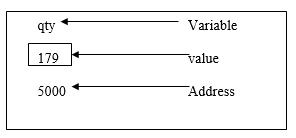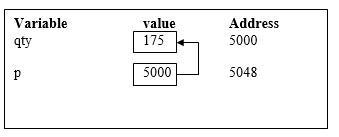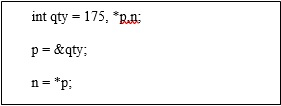
 Data Structure
Data Structure Networking
Networking RDBMS
RDBMS Operating System
Operating System Java
Java MS Excel
MS Excel iOS
iOS HTML
HTML CSS
CSS Android
Android Python
Python C Programming
C Programming C++
C++ C#
C# MongoDB
MongoDB MySQL
MySQL Javascript
Javascript PHP
PHP
- Selected Reading
- UPSC IAS Exams Notes
- Developer's Best Practices
- Questions and Answers
- Effective Resume Writing
- HR Interview Questions
- Computer Glossary
- Who is Who
Explain pointers and one-dimensional array in C language
Pointer is a variable that stores the address of another variable.
Features
The features of pointer are explained below −
- Pointer saves the memory space.
- Execution time of pointer is faster because of direct access to the memory location.
- With the help of pointers, the memory is accessed efficiently, i.e., memory is allocated and deallocated dynamically.
- Pointers are used with data structures.
Pointer declaration, initialization and accessing
Consider the following statement −
int qty = 179;
In memory, the variable can be represented as follows −

Declaring a pointer
It means ‘p’ is a pointer variable which holds the address of another integer variable, as mentioned in the statement below −
Int *p;
Initialization of a pointer
Address operator (&) is used to initialise a pointer variable.
For example −
int qty = 175; int *p; p= &qty;

Accessing a variable through its pointer
To access the value of a variable, indirection operator (*) is used.
For example −

Here, ‘*’ can be treated as value at address.
The two statements are equivalent by the following statement −
p = &qty; n = *p; n =qty
Pointers and one-dimensional arrays
- The compiler allocates Continuous memory locations for all the elements of the array.
- The base address = first element address (index 0) of the array.
- For Example − int a [5] = {10, 20,30,40,50};
Elements
The five elements are stored as follows −

If ‘p’ is declared as integer pointer, then, an array ‘a’ can be pointed by the following assignment −
p = a; (or) p = &a[0];
Every value of 'a' is accessed by using p++ to move from one element to another element. When a pointer is incremented, its value is increased by the size of the datatype that it points to. This length is called the "scale factor".
The relationship between ‘p’ and 'a' is explained below −
P = &a[0] = 1000 P+1 = &a[1] = 1004 P+2 = &a[2] = 1008 P+3 = &a[3] = 1012 P+4 = &a[4] = 1016
Address of an element is calculated using its index and the scale factor of the datatype. An example to explain this is given herewith.
Address of a[3] = base address + (3* scale factor of int) = 1000 + (3*4) = 1000 +12 = 1012
Pointers can be used to access array elements instead of using array indexing.
*(p+3) gives the value of a[3].
a[i] = *(p+i)
Example program
Following is the C program for pointers and one-dimensional arrays −
#include<stdio.h>
main ( ){
int a[5];
int *p,i;
printf ("Enter 5 lements");
for (i=0; i<5; i++)
scanf ("%d", &a[i]);
p = &a[0];
printf ("Elements of the array are");
for (i=0; i<5; i++)
printf("%d", *(p+i));
}
Output
When the above program is executed, it produces the following result −
Enter 5 elements : 10 20 30 40 50 Elements of the array are : 10 20 30 40 50

